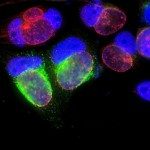Lien vers Pubmed [PMID] – 18369472
PLoS Pathog. 2008 Mar;4(3):e1000022
Many intracellular pathogens rely on host cell membrane compartments for their survival. The strategies they have developed to subvert intracellular trafficking are often unknown, and SNARE proteins, which are essential for membrane fusion, are possible targets. The obligate intracellular bacteria Chlamydia replicate within an intracellular vacuole, termed an inclusion. A large family of bacterial proteins is inserted in the inclusion membrane, and the role of these inclusion proteins is mostly unknown. Here we identify SNARE-like motifs in the inclusion protein IncA, which are conserved among most Chlamydia species. We show that IncA can bind directly to several host SNARE proteins. A subset of SNAREs is specifically recruited to the immediate vicinity of the inclusion membrane, and their accumulation is reduced around inclusions that lack IncA, demonstrating that IncA plays a predominant role in SNARE recruitment. However, interaction with the SNARE machinery is probably not restricted to IncA as at least another inclusion protein shows similarities with SNARE motifs and can interact with SNAREs. We modelled IncA’s association with host SNAREs. The analysis of intermolecular contacts showed that the IncA SNARE-like motif can make specific interactions with host SNARE motifs similar to those found in a bona fide SNARE complex. Moreover, point mutations in the central layer of IncA SNARE-like motifs resulted in the loss of binding to host SNAREs. Altogether, our data demonstrate for the first time mimicry of the SNARE motif by a bacterium.


